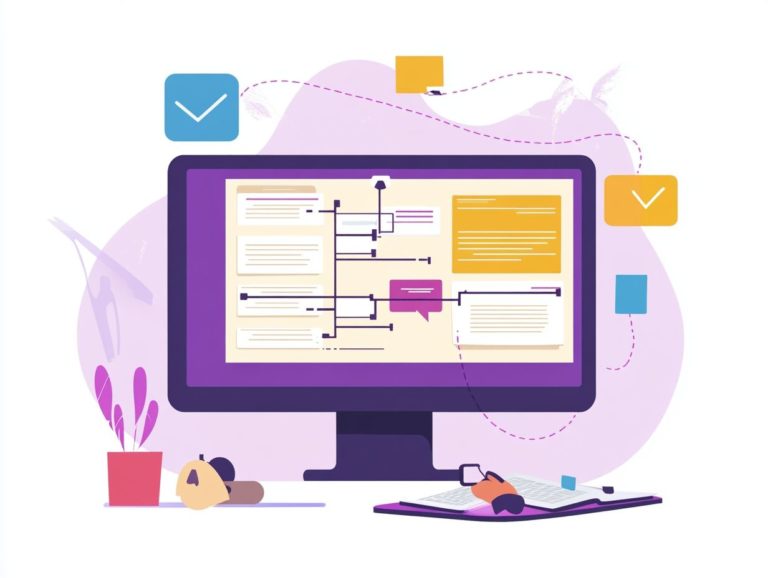5 Common Myths About Cloud Migration Debunked
Cloud migration is often clouded by misconceptions that may prevent you from fully embracing its advantages.
You might think it s a one-time process, too expensive, or solely reserved for large enterprises. You may also be concerned about losing control or jeopardizing your security.
This article sets the record straight by debunking these prevalent myths. It offers a clearer perspective on what cloud migration really involves, delving into its significance, benefits, challenges, and providing insights on how your business can prepare for a seamless transition.
Join us as we clarify these facts and assist you in determining whether cloud migration is the right move for your organization!
Contents
- Key Takeaways:
- 1. Cloud Migration Is a One-Time Process
- 2. Moving to the Cloud Means Giving Up Control
- 3. Cloud Migration Is Expensive
- 4. Cloud Migration Is Only for Big Companies
- 5. Cloud Migration Is a Security Risk
- What Is Cloud Migration and Why Is It Important?
- What Are the Steps Involved in Cloud Migration?
- What Are the Benefits of Cloud Migration?
- What Are the Challenges of Cloud Migration?
- How Can a Business Prepare for Cloud Migration?
- What Are the Different Types of Cloud Migration?
- How Can a Business Ensure Data Security During Cloud Migration?
- What Are the Long-Term Effects of Cloud Migration on a Business?
- What Are the Alternatives to Cloud Migration?
- What Are the Common Misconceptions About Cloud Migration?
- How Can a Business Determine If Cloud Migration Is Right for Them?
- Frequently Asked Questions
- What are the common myths surrounding cloud migration?
- Is it true that the cloud is not secure?
- Is it more expensive to migrate to the cloud?
- Is the cloud only suitable for large businesses?
- Do I need to completely overhaul my current systems to migrate to the cloud?
- Is implementing the cloud complicated?
Key Takeaways:

- Cloud migration is an ongoing process, not a one-time event.
- You retain control over your data and infrastructure.
- Cloud migration can be cost-effective and lead to savings over time.
1. Cloud Migration Is a One-Time Process
You might see cloud migration as a one-and-done deal. However, it involves a series of ongoing challenges and adaptations that you, as an IT leader, must navigate.
Fully leveraging cloud benefits, like enhanced operational efficiency and flexibility, is crucial for meeting your organization s needs in today s rapidly changing digital landscape.
This misconception could lead you to overlook problems that can arise later due to past decisions. You also need to stay compliant with various regulations governing data handling and security. This adds another layer of complexity to your efforts.
Strategic planning around cloud architecture is essential for building a framework that meets your current requirements and adapts to upcoming advancements.
Therefore, the journey through cloud migration isn t just a destination; it s a dynamic path requiring your constant attention and modification to truly thrive and innovate.
2. Moving to the Cloud Means Giving Up Control
One common misconception about cloud migration is that it means giving up control over your data and infrastructure. In reality, many cloud providers offer robust security features and governance options that enable you to maintain oversight and compliance.
To navigate this landscape effectively, implement stringent access controls and identity management strategies. This ensures that only authorized personnel can access sensitive information. You need to adopt multi-factor authentication, employ role-based access permissions, and continuously monitor user activities.
Cloud services like AWS, Azure, and Google Cloud enhance data security by providing built-in encryption and compliance frameworks. It s essential to thoroughly understand the service-level agreements (SLAs) to clarify responsibilities and expectations regarding data protection. This allows you to leverage the advantages of the cloud while safeguarding your assets.
3. Cloud Migration Is Expensive
Don t let the initial costs scare you! While you may initially perceive cloud migration as a costly venture, it has the potential to yield significant cost savings and optimization over time.
By reducing your reliance on legacy systems and enhancing operational efficiency through scalable cloud-based applications, you set the stage for long-term financial benefits.
Yes, the upfront expenses like subscription fees and migration services might feel intimidating. However, you can offset these initial costs by cutting out hefty maintenance fees tied to on-premises infrastructure.
With cloud economics at your disposal, embrace pay-as-you-go models that enable you to scale resources in line with your actual needs. For instance, if you run a retail business, you can lower your expenses during off-peak seasons by adjusting your cloud services to match demand.
The potential return on investment (ROI) is noteworthy, as many companies report reduced downtime and increased agility. This leads to greater innovation and improved customer satisfaction over time, making the initial leap into cloud migration well worth it.
Ready to explore the cloud? Let s embark on this journey together and unlock new possibilities for your business!
4. Cloud Migration Is Only for Big Companies
The idea that cloud migration is solely for large corporations overlooks the wealth of benefits available to small businesses. Embracing the cloud enhances your agility. It opens opportunities for digital transformation and provides access to advanced applications that level the competitive playing field.
By adopting cloud computing, your enterprise can manage resources more efficiently. You can streamline operations and adapt swiftly to shifting market demands.
Consider a local bakery that migrated to the cloud. They implemented inventory management software that tracked ingredients in real time. This dramatically reduced waste and cut costs.
Then there’s a small marketing agency that harnessed cloud-based collaboration tools. Team members worked seamlessly from remote locations. This not only fostered greater creativity but also significantly boosted productivity.
These real-world stories show how cloud migration can supercharge your efficiency while driving innovation capabilities that were once out of reach for smaller organizations.
5. Cloud Migration Is a Security Risk
Some may perceive cloud migration as a security gamble, but many cloud providers have implemented comprehensive security strategies. These include cutting-edge encryption solutions and regular security assessments designed to ensure robust data security and compliance with regulations like HIPAA and GDPR.
These measures protect sensitive information and inspire confidence in businesses considering the move to the cloud. Beyond encryption, cloud providers typically employ multi-factor authentication and intrusion detection systems to prevent unauthorized access.
Before you begin your migration journey, conduct a thorough security assessment. This will help you identify potential vulnerabilities and align your security framework with that of the cloud service provider.
Maintaining data sovereignty requires careful scrutiny of where your data is stored and processed. This ensures compliance with regional laws and regulations. Such an approach reinforces a strong data governance strategy throughout the cloud adoption process.
What Is Cloud Migration and Why Is It Important?

Cloud migration is the process of transferring data, applications, and other business elements from on-premises infrastructure to cloud-based environments. It s a crucial step in digital transformation that aligns seamlessly with contemporary business strategies and addresses the growing demands for scalability and efficiency.
This journey encompasses various methodologies:
- Lift-and-shift: Moving applications to the cloud with minimal changes.
- Re-platforming: Updating applications to take full advantage of cloud features.
- Re-factoring: Redesigning applications to optimize for cloud use.
The significance of cloud migration is profound. It allows your organization to enhance infrastructure management through improved resource allocation and decreased operational costs. It also fosters business agility by enabling you to scale resources up or down in response to demand. This positions your organization competitively in an ever-evolving market landscape.
Embrace cloud migration today and stay competitive in a fast-changing market!
What Are the Steps Involved in Cloud Migration?
The cloud migration process is built upon several essential steps. Each step requires careful attention, including thorough planning, execution, testing, and training employees for a seamless transition to cloud-based environments.
Every stage is crucial in minimizing disruptions and ensuring your organization can fully harness the advantages of cloud technology.
It all starts with strategic planning, which involves a comprehensive assessment of your current infrastructure and workflows. This helps you identify potential risks and opportunities for enhancement.
Once you have a robust migration strategy, the meticulous execution phase kicks in. This is where you ll configure the cloud environment and securely migrate your data.
Testing is essential to confirm that all systems function properly after migration.
Don’t overlook the importance of effective training programs. They enable your employees to navigate new applications with ease, boosting adaptability and operational efficiency across the board.
What Are the Benefits of Cloud Migration?
Cloud migration presents a wealth of benefits that can transform your business landscape. You ll experience cost savings, enhanced flexibility, increased speed, and improved productivity all contributing to greater business continuity and resilience in today’s fast-paced market.
When you make the leap to the cloud, you re likely to see significant reductions in IT infrastructure costs. This shift allows you to shed the burden of extensive on-premises equipment. Picture a retail company reallocating those savings into cutting-edge customer service technologies, resulting in quicker response times to consumer inquiries.
The flexibility of cloud services means you can easily scale your resources, which is a game changer during peak shopping seasons. For instance, an e-commerce platform can swiftly ramp up server capacity to manage surges in traffic.
This agility eliminates the long lead times typically associated with traditional IT setups, enabling you to adapt quickly to emerging market trends. By positioning yourself this way, you re not just keeping pace; you re setting the standard against your competitors.
What Are the Challenges of Cloud Migration?
While cloud migration offers a wealth of benefits, it doesn t come without its challenges performance issues, potential security risks, managing outdated technology issues, and navigating compliance regulations are hurdles that require careful attention.
To tackle these challenges effectively, engage in thorough planning and assessment to truly understand your unique environment. Developing a structured migration strategy should be a top priority, one that emphasizes risk management techniques like phased migration and robust testing protocols.
This approach ensures that any vulnerabilities are caught early on, giving your team the opportunity to adapt their strategies as needed.
Continuous assessment throughout the migration process is essential. It allows you to refine your strategies and respond dynamically to any emerging challenges. By staying vigilant and adaptable, you can mitigate risks and significantly improve your chances of a successful transition to the cloud.
How Can a Business Prepare for Cloud Migration?
Preparing for cloud migration requires crafting a comprehensive strategy that includes a deep understanding of your organizational needs, employee training, and effective resource governance to ensure a smooth transition.
To kick off this process, start by conducting a thorough assessment of your current infrastructure. This will help you identify gaps and pinpoint areas ripe for improvement.
Next, explore various cloud solutions that align with your specific operational demands, ensuring both scalability and cost-effectiveness. Engaging in detailed discussions with cloud service providers can further clarify your options, paving the way for knowledge-based decision making.
As you integrate the new system, planning tailored training sessions for your employees will be essential. This approach will ease the adaptation process, boosting their confidence and productivity in leveraging cloud technologies.
You ll want to act quickly to reap these benefits! Start your cloud migration journey today!
What Are the Different Types of Cloud Migration?
Cloud migration can be approached in several ways: public cloud, private cloud, and hybrid cloud migrations. Each option presents distinct advantages that align with various business strategies and infrastructure management needs.
Understanding these distinctions is essential as you evaluate which approach best supports your operational goals and resource allocation.
Public cloud migrations allow you to tap into extensive and scalable cloud resources, leading to significant cost savings and increased flexibility.
Conversely, private cloud migrations provide enhanced security and control, making them ideal for organizations facing strict regulatory requirements or handling sensitive data.
Hybrid cloud migrations offer the best of both worlds, allowing you to combine public and private cloud solutions. This blend gives you the versatility to manage workloads in response to evolving demands.
Your decision should reflect considerations such as budget constraints, compliance mandates, and the necessity for operational agility.
How Can a Business Ensure Data Security During Cloud Migration?

To ensure data security during your cloud migration, you must implement robust security strategies that include encryption tools, incident response plans, and thorough assessments of your cloud providers’ security features.
Choosing a cloud provider known for excellent security is key to protecting your valuable data! Review certifications, data handling practices, and the provider’s track record regarding security breaches to make informed choices.
Targeted employee training programs are essential; they equip your staff with the knowledge to recognize potential threats and adhere to best practices.
This proactive approach strengthens your security and fosters a culture of vigilance that endures long after the transition is complete.
What Are the Long-Term Effects of Cloud Migration on a Business?
The long-term effects of cloud migration include enhanced operational efficiency, improved productivity, and the ability to adapt your business strategy in response to shifting market dynamics.
Many organizations showcase these benefits through their transformative journeys. For example, a leading retail company transitioned to cloud-based solutions, resulting in a streamlined inventory management system that significantly reduced costs while boosting customer service.
A healthcare provider adopted cloud technology to optimize patient record management, allowing for faster data access and improved care delivery.
These examples demonstrate how leveraging cloud technologies drives immediate operational improvements and cultivates a culture of continuous innovation, enabling you to pivot swiftly in an ever-evolving landscape.
What Are the Alternatives to Cloud Migration?
While cloud migration certainly has its allure, you might want to explore alternatives like maintaining on-premises infrastructure or embracing hybrid solutions that effectively support your organization s digital transformation journey.
These alternatives grant you greater control over your data and systems, along with the flexibility needed to manage workloads.
For instance, keeping certain critical applications on-site enhances security and compliance, especially when handling sensitive information.
Hybrid solutions combine both cloud and on-premises resources for flexibility, allowing you to operate legacy systems alongside modern cloud applications, thus optimizing your resource allocation.
However, it’s crucial to weigh potential integration challenges and the complexities that might arise from managing multiple environments. These factors could significantly influence your operational efficiency and overall cost-effectiveness.
What Are the Common Misconceptions About Cloud Migration?
Common misconceptions about cloud migration can hold you back. Many believe it’s prohibitively expensive, that it means losing control, or that it poses significant data security risks. Understanding the 5 key takeaways from successful cloud migrations can help dispel these myths.
These ideas can deter your organization from exploring the potential benefits of cloud migration. In reality, many businesses find that moving to the cloud can lower costs by using resources more effectively and leveraging scalable infrastructure.
The notion that you must forfeit control is misleading; you retain substantial management capabilities through different ways to use cloud services. With advancements in security protocols and compliance measures, cloud providers often offer enhanced protection that surpasses traditional on-premises systems.
Tackling these misconceptions allows you to rethink your strategies and unlock greater efficiency and innovation.
How Can a Business Determine If Cloud Migration Is Right for Them?
To determine whether cloud migration is the right move for your organization, conduct a thorough risk assessment. This should align seamlessly with your business strategy while addressing your specific needs and goals.
Start by examining your existing infrastructure. Assess both your hardware and software capabilities, and pinpoint any gaps that could pose challenges during migration. Understanding your unique requirements is crucial analyze your workloads, the sensitivity of your data, and any compliance mandates that could influence your choice of cloud services.
Next, outline what you hope to achieve through migration. Whether it’s improved scalability, cost savings, or enhanced collaboration, having clear objectives will guide your journey.
Remember, risk management is essential. It helps you identify potential pitfalls and establish contingency plans, ensuring a smooth transition that aligns with your business objectives and broader strategic goals.
Frequently Asked Questions
What are the common myths surrounding cloud migration?

Some common myths include: the cloud is not secure, it is more expensive than traditional systems, it is only suitable for large businesses, it requires a complete overhaul of current systems, and it is complicated to implement. To address these misconceptions, consider the 5 key considerations for cloud migration planning.
Is it true that the cloud is not secure?
No, this is a misconception. Cloud service providers have strict security measures in place to protect your data, often more advanced than traditional systems.
Is it more expensive to migrate to the cloud?
Not necessarily. While there may be upfront costs for migration, the long-term cost savings from not maintaining physical servers can make it more cost-effective.
Is the cloud only suitable for large businesses?
No, the cloud can benefit businesses of all sizes. Smaller businesses often see significant cost savings and increased efficiency from migrating to the cloud.
Do I need to completely overhaul my current systems to migrate to the cloud?
No, cloud migration can be done gradually and in phases, allowing for integration with your current systems. This minimizes disruption and makes the process more manageable.
Is implementing the cloud complicated?
No, with the help of a reliable cloud service provider and proper planning, migrating to the cloud can be smooth and straightforward. It is essential to have a solid plan and involve all stakeholders in the process.






